Buchanan VisionCare Plan
Save money and get lots of benefits
The Buchanan Optometrists vision care plan is a loyalty scheme that covers the cost of your eye examination by paying a small monthly fee. You also get a range of benefits such as discounts when you order complete spectacles, insurance on your spectacles, second pair discounts, and priority booking, to name but a few. The vision care plan starts from only £5 per month. We recommend our 1st tier examination as this is the most comprehensive and allows us to detect eye conditions as soon as possible. This table shows you what is included in each examination. You can find out more about the scans by clicking on the name of the scan. If you are not sure which examination would suit you best then you can watch a short video and read our frequently asked questions about eye examinations.
| 1st Tier | 2nd Tier | 3rd Tier | |
| Eye Examination & Prescription | ✔ | ✔ | ✔ |
| Standard Visual Field Testing | ✔ | ✔ | ✔ |
| Widefield Imaging | ✔ | ✔ | ✔ |
| Air Puff Tonometry | ✔ | ✔ | ✔ |
| Goldmann Tonometry | ✔ | ✔ | £45 |
| Baseline Ongoing Monitoring | ✔ | ✔ | - |
| Corneal Thickness | ✔ | ✔ | £50 |
| Anterior chamber imaging | ✔ | ✔ | £50 |
| Colour Widefield Imaging | ✔ | ✔ | £50 |
| High Speed OCT Scans | ✔ | ✔ | £50 |
| High Speed Macula Scans | ✔ | ✔ | £50 |
| Standard Glaucoma OCT Scans | ✔ | ✔ | £50 |
| GMPE Advanced Glaucoma Scans | ✔ | £160 | £160 |
| Dilation* | ✔ | £80 | £80 |
| Corneal Imaging | ✔ | £50 | £50 |
| High resolution OCT Scans | ✔ | £80 | £80 |
| High Resolution Macula Scans | ✔ | £80 | £80 |
| BAF Macula Degeneration scan* | ✔ | £95 | £95 |
| Optic Nerve Head 3D Scan | ✔ | £50 | £50 |
| Comprehensive report | ✔ | £65 | £65 |
| Advanced Visual Field Testing | ✔ | £60 | £60 |
| Cost Not on Loyalty Scheme | £390 | £275 | £150 |
| Savings | £1065 | £345 | - |
| VisionCare Plan Costs & Benefits | |||
| Monthly Cost for a 2 yearly visit | £12.50 | £9 | £5 |
| Monthly Cost for a 1 yearly visit | £25 | £18 | £10 |
| Savings | £1155 | £404 | £30 |
| Discount on Complete Spectacles | 15% | 10% | 5% |
Most opticians rely on pressure testing and visual field testing to detect glaucoma but using these traditional techniques alone can mean that up to 40% of the nerve fibre layer at the back of the eye may have already been lost by the time the tests show it up. Any nerve damage is permanent and therefore we need to detect nerve damage at a much earlier stage to allow us to save more of your eyesight.
Heidelberg Spectralis 4D Optical Coherence Tomographer scans can detect any nerve damage up to 8 years earlier than conventional methods, which means treatment can be started sooner. The scans not only confirm the presence of glaucoma but also provide a baseline to accurately detect any abnormal loss of nerve fibres in the future thus allowing more accurate management of the condition.
Again unlike most opticians we now also look at the distribution of your nerve fibres across the macula which is now understood to be another early sign of glaucoma in addition to the extra measurements that we take.
Standard scans measure the optic nerve rim width and central nerve fibres, these scans are far more accurate than just relying on pressure tests and visual field tests to diagnose glaucoma.
Advanced GMPE scans measure the optic nerve rim width radially at 3 locations, Radial thickness at 48 locations on the optic nerve and central nerve fibre thickness in 2 orientations. Advanced scans are better for early detection and ongoing monitoring of the condition than the standard scans.
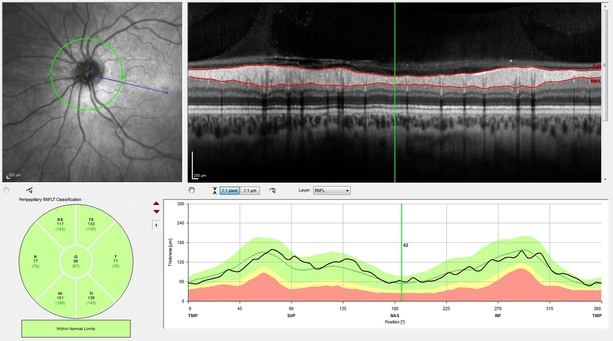
Anterior chamber imaging
Closed-angle glaucoma is a rarer form of glaucoma that can cause pain, blurring, and quick onset sight loss. We can now scan your eyes and predict the likelihood of this occurring. If the scan identifies a risk you may, at any age, be entitled to preventative laser treatment which can stop closed-angle glaucoma from occurring in the future.

Buchanan Optometrists Ltd is one of the few optometry practices in the UK to own the Heidelberg Spectralis Optical Coherence Tomographer Scanner widely regarded as the pinnacle in early glaucoma detection.
We recommend advanced glaucoma screening for everyone over 35. Book your appointment today and prevent sight loss. Call us on 01634 240645 or click the Call me back button at the top of this page.
Macula 4D OCT Scans detect the earliest signs of both dry and wet macular degeneration, macula holes, oedema, congenital defects, Epi-retinal membranes as well as many other conditions and help us to carefully monitor any progression of the condition.
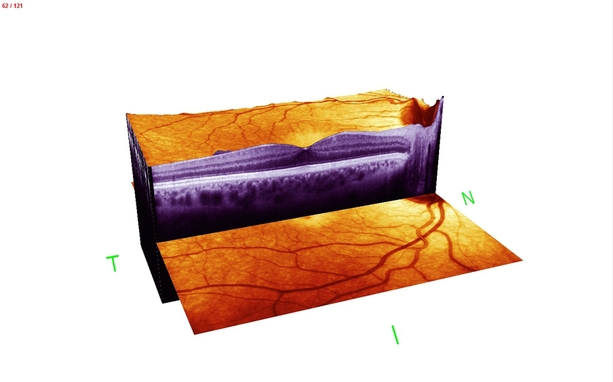
BAF Macular degeneration scan
The scan maps the areas and density of lipofuscin (cellular waste products) allowing us to diagnose quickly and non-invasively and monitor some retinal diseases, most of which are still largely under-diagnosed and, therefore, undertreated. By measuring the level of lipofuscin in the retinal cells, we can see if the retina is working efficiently (normal lipofuscin levels), at risk of damage (increasing lipofuscin) or damaged beyond repair (too much lipofuscin).

Corneal thickness
Measuring the corneal thickness is extremely useful to help predict those who may be more at risk of glaucoma. We have 3 different methods to measure the corneal thickness, all are non-invasive and painless. Your optometrist will choose which method is most suitable for you.
Corneal imaging
OCT scanning of the cornea allows better detection and monitoring of conditions such as keratoconus and corneal disease.
Wide-field imaging
This scan of the far peripheral retina allows us to look into parts of the eye we would never normally see. It can help detect retinal defects such as retinal detachment, tears and floaters. Standard ophthalmoscopy (used frequently in eye examinations) allows us to see ? degrees of the retina at one time, Wide-field OCT scanning allows 55degreees.
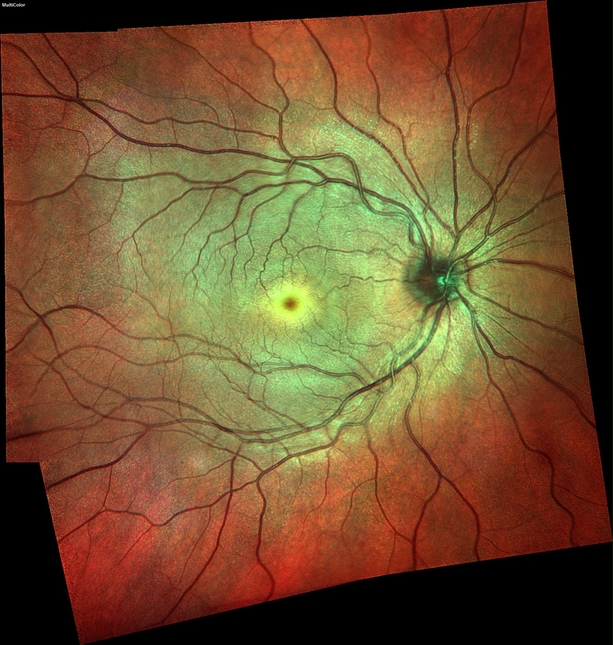
Optic Nerve Head 3D scan
This scan can allow us to detect nerve defects that can be caused by a number of conditions such as MS, space-occupying lesions, and raised intra-cranial pressure.
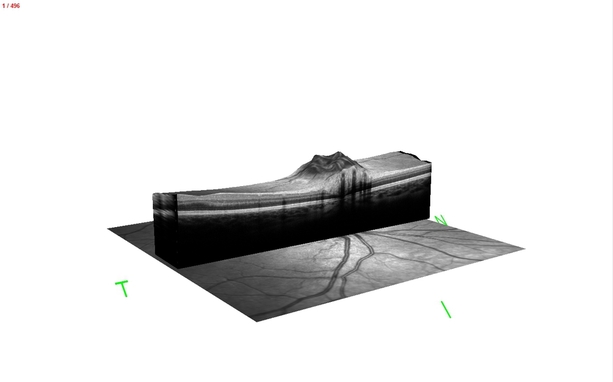
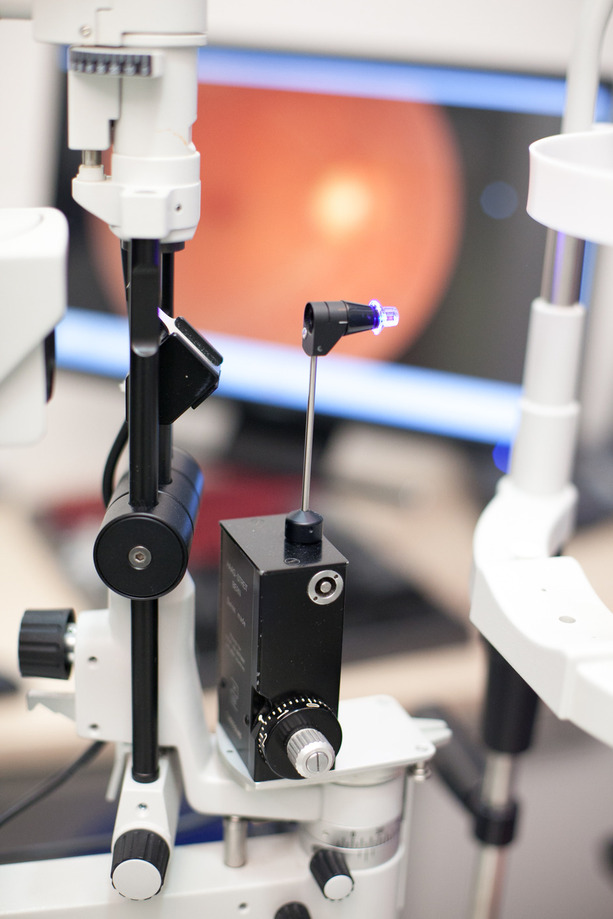
Goldman tonometry or air puff tonometry
Both methods measure the pressure of your eye. The Goldmann is considered the gold standard and used in hospital glaucoma clinics. The air puff is also very accurate but not comparable to the Goldmann pressures. Some people prefer the Goldmann method as there is no puff of air or discomfort.
Dilation
This involves putting drops into your eyes to dilate your pupils. This is often used for more accurate assessment of the retina and cataracts.
Advanced visual field test
You can lose part or all of your visual field through many different ways including cataracts, glaucoma, strokes, circulatory disorders, neurological conditions, certain brain tumours and even smoking. It is essential to have your visual field regularly assessed as many conditions, if caught early, can be treated. Unlike basic visual field screening which concentrates on evaluating large chunks of your vision at a time, the Humphrey Visual Field Analyser advanced visual field test can pick up even very subtle defects in your visual field by analysing each nerve pathway in detail. 
Return to Table
OCT Scans
High Resolution or High Speed?
The difference between these is the quality of the image. For a high-resolution scan we use up to 100 images to produce one very high-resolution scan - the best there is in the industry, this means we can see the minutest changes within the eye. A high-speed scan may be made up of 1 to 15 images and the quality is not quite as good, but we can still see a lot more detail than in a basic sight test.
Baseline OCT scans and ongoing monitoring
The new Spectralis 4D OCT can help us diagnose and monitor eye conditions such as glaucoma, macula degeneration, diabetic eye disease, hypertensive retinal changes, macula disease, retinal holes, oedema and many more with the accuracy of one thousandth of a millimetre. Heidelberg OCT scans help us to diagnose conditions up to 8 years sooner than a standard eye examination. Earlier detection leads to earlier treatment, a better prognosis and in some cases prevention of conditions developing at all.
We recommend Spectralis 4D OCT scanning for all patients as it not only acts as a very thorough assessment of your eye health but also an excellent baseline for future comparison to help diagnose any changes at the earliest signs. Scanning is particularly advisable for anyone that has been diagnosed with cataracts, macular degeneration, glaucoma, diabetes, is over 40 years old or has a family history of any of these conditions.
The Spectralis 4D OCT scan not only helps us detect eye conditions but can sometimes also show signs associated with brain tumours, high cholesterol or uncontrolled blood pressure thus saving further health problems in the future and may even help prevent a stroke or heart attack.
Book your appointment today on 01634 757227 or click HERE and we will call you straight back!
Return to Table





